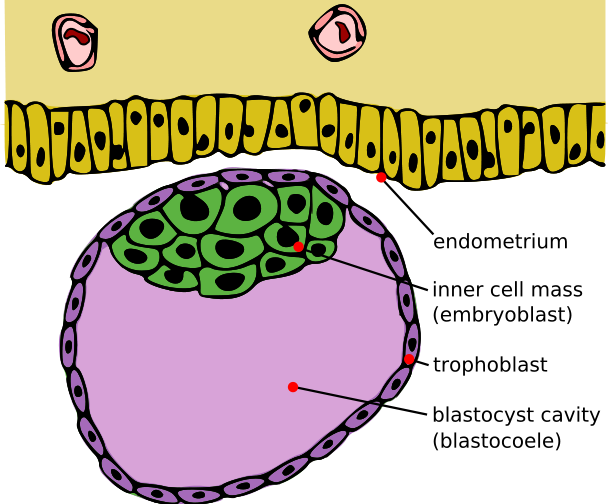Human embryogenesis
Overview
Human embryogenesis is the process of cell division and cellular differentiation of the human embryo during early prenatal development. It spans from the moment of fertilization to the end of the 8th week of gestational age, whereafter it is called a fetus.
From one cell to blastocyst
A human develops from a single cell called a zygote, which results from an ovum (egg) being fertilized by a single spermatozoon (sperm). The cell is surrounded by a strong membrane of glycoproteins called the zona pellucida which the successful sperm has managed to penetrate.
The zygote undergoes cleavage, increasing the number of cells within the zona pellucida. After the 8-cell stage, embryos undergo what is called compactation, where the cells bind tightly to each other, forming a compact sphere. After compactation, the embryo is in the morula stage (16 cells). Cavitation occurrs next, where the outermost layer of cells - the trophoblast - secrete water into the morula. As a consequence of this when the number of cells reaches 40 to 150, a central, fluid-filled cavity (blastocoel) has been formed. The zona pellucida begins to degenerate, allowing the embryo to increase its volume. This stage in the developing embryo, reached after four to six days, is the blastocyst (akin to the blastula stage), and lasts approximately until the implantation in the uterus.
Blastocyst differentiation

The blastocyst is characterized by a group of cells, called the inner cell mass (also called embryoblast) and the mentioned trophoblast (the outer cells).
The inner cell mass gives rise to the embryo proper, the amnion, yolk sac and allantois, while the trophoblast will eventually form the placenta. The blastocyst can be thought of as a ball of a (mostly single) layer of trophoblast cells, with the inner cell mass attached to this ball's inner wall. The embryo plus its membranes is called the conceptus. By this stage the conceptus is in the uterus. The zona pellucida ultimately disappears completely, allowing the blastocyst to invade the endometrium, performing implantation.
Implantation
The trophoblast then differentiates into two distinct layers: the inner is the cytotrophoblast consisting of cuboidal cells that are the source of dividing cells, and the outer is the syncytiotrophoblast.
The syncitotrophoblast implants the blastocyst in the endometrium (innermost epithelial lining) of the uterus by forming finger-like projections called chorionic villi that make their way into the uterus, and spaces called lacunae that fill up with the mother's blood. This is assisted by hydrolytic enzymes that erode the epithelium. The syncytiotrophoblast also produces human chorionic gonadotropin (hCG), a hormone that "notifies" the mother's body that she is pregnant, preventing menstruation by sustaining the function of the corpus luteum. The villi begin to branch, and contain blood vessels of the fetus that allow gas exchange between mother and child.
Inner cell mass differentiation
While the syncytiotrophoblast starts to penetrate into the wall of the uterus, the inner cell mass (embryoblast) also develops.
The embryoblast forms a bilaminar (two layered) embryo, composed of the epiblast and the hypoblast. The epiblast is adjacent to the trophoblast and made of columnar cells; the hypoblast is closest to the blastocyst cavity, and made of cuboidal cells. The epiblast, now called primitive ectoderm will perform gastrulation, approximately at day 16 after fertilization. In this process, it gives rise to all three germ layers of the embryo: ectoderm, mesoderm, and endoderm. The hypoblast, or primitive endoderm, will give rise to extraembryonic structures only, such as the lining of the primary yolk sac.
Cavity formation
By separating from the trophoblast, the epiblast forms a new cavity, the amniotic cavity. This is lined by the amnionic membrane, with cells that come from the epiblast (called amnioblasts). Some hypoblast cells migrate along the inner cytotrophoblast lining of the blastocoel, secreting an extracellular matrix along the way. These hypoblast cells and extracellular matrix are called Heuser's membrane (or exocoelomic membrane), and the blastocoel is now called the primary yolk sac (or exocoelomic cavity).
Cytotrophoblast cells and cells of Heuser's membrane continue secreting extracellular matrix between them. This matrix is called the extraembryonic reticulum. Cells of the epiblast migrate along the outer edges of this reticulum and form the extraembryonic mesoderm, which makes it difficult to maintain the extraembryonic reticulum. Soon pockets form in the reticulum, which ultimately coalesce to form the chorionic cavity or extraembryonic coelom.
Another layer of cells leaves the hypoblast and migrates along the inside of the primary yolk sac. The primary yolk sac is pushed to the opposite side of the embryo (the abembryonic pole), while a new cavity forms, the secondary or definitive yolk sac. The remnants of the primary yolk sac are called exocoelomic vesicles.
Susceptibility
Toxic exposures during the first two weeks following fertilization (second and third weeks of gestational age) may cause prenatal death but do not cause developmental defects. Instead, the body performs a miscarriage. On the other hand, subsequent toxic exposures in the embryonic period often cause major congenital malformations, since the precursors of the major organ systems are developing.
See also
- Mammalian embryogenesis, for other mammals
- Embryogenesis, for other species than humans
- Developmental biology
- Blastomere
- Morula
- Cdx2